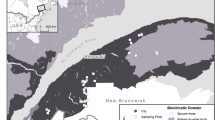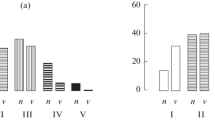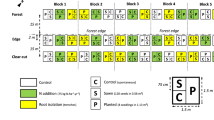Abstract
The relationship between competition and tree growth was studied in four stands of Pinus sylvestris L. occurring in a continental Mediterranean mountain area (in the Guadarrama range, Spain), i.e., an uneven-aged stand, a stand with oak (Quercus pyrenaica Willd.) understorey, a plantation, and a mature even-aged stand. Competition was measured by a simple size-ratio distance-independent index and was negatively associated with tree diameter. This negative association was stronger in the uneven-aged, plantation and mature even-aged stands than in the stand with oak understorey. Competition was also negatively associated with current diameter increment. This relationship was moderately strong in the mature even-aged stand and weak in the uneven-aged stand and the plantation. In the uneven-aged and the mature even-aged stands, a weakly significant relationship was found between diameter growth and tree size, whereas these parameters were not associated in the stand with oak understorey. The competition index provided a better prediction of growth rate than the alternative use of diameter. Both diameter and basal area growth were greater in the uneven-aged than in the even-aged stands.
Résumé
La relation entre compétition et croissance a été étudiée dans quatre peuplements de Pinus sylvestris L. que l’on rencontre dans la zone continentale des montagnes méditerranéennes (dans la région de Guadarrama en Espagne). Ont été pris en compte un peuplement inéquienne, un peuplement avec du chêne (Quercus pyrenaica Willd.) en sous—étage, une plantation, et un peuplement équienne âgé. La compétition a été mesurée par un index indépendant, simple rapport taille/distance, et était corrélée négativement avec le diamètre des arbres. Cette corrélation négative était plus forte dans le peuplement inéquienne, la plantation et le peuplement équienne âgé que dans le peuplement avec sous-étage de chêne. L’index de compétition était aussi corrélé négativement avec l’accroissement courant en diamètre. La relation était modérément forte dans le peuplement équienne âgé et faible dans le peuplement inéquienne et la plantation. Dans le peuplement inéquienne et le peuplement équienne âgé une relation faiblement significative a été trouvée entre croissance en diamètre et taille de l’arbre, alors que ces paramètres n’étaient pas corrélés dans le peuplement avec sous-étage de chêne. L’index de compétition fournit une meilleure prédiction du taux de croissance que le simple diamètre. La croissance en diamètre et en surface terrière était plus importante dans le peuplement inéquienne que dans le peuplement équienne âgé.
Similar content being viewed by others
References
Biging G.S., Dobbertin M., A comparison of distance-dependent competition measures of height and basal area growth of individual conifer trees, For. Sci. 38 (1992) 695–720.
Biging G.S., Dobbertin M., Evaluation of competition indices in individual tree growth models, For. Sci. 41 (1995) 360–377.
Castedo-Dorado F., Dieguez-Aranda U., Alvarez-Gonzalez J.G., A growth model for Pinus radiata D. Don stands in northwestern Spain, Ann. For. Sci. 64 (2007) 609–619.
Diéguez-Aranda U., Álvarez-González J.G., Barrio-Anta M., Rojo-Alboreca A., Site quality equations for Pinus sylvestris L. plantations in Galicia (northwestern Spain), Ann. For. Sci. 62 (2005) 143–152.
Gandullo J.M., Nicolas A., Ecología de los pinares españoles. Ministerio de agricultura, I.F.I.E., Madrid, 1969.
Garcia-Abejon J.L., Gomez-Loranca J.A., Tablas de productión de densidad variable para Pinus sylvestris L. en el Sistema Central, INIA, Madrid, 1984.
Gonzalez S.C., Bravo F., Inventario y descriptión de la regeneratión natural. Aplicación a grupos ordenados de pino silvestre (Pinus sylvestris L.) del Alto Ebro (Burgos), Montes 50 (1997) 21–28.
Harrod R.J., McRae B.H., Hartl W.E., Historical stand reconstruction in ponderosa pine forests to guide silvicultural prescriptions, For. Ecol. Manage. 114 (1999) 433–446.
Hegyi F., A simulation model for managing jack-pine stands, in: Fries J. (Ed.), Growth model for tree and stand simulation, Royal Coll. For., Stockholm, Sweden, 1974, pp. 74–90.
Holmes M.J., Reed D.D., Competition indices for mixed species Northern hardwoods, For. Sci. 37 (1991) 1338–1349.
Jäghagen K., Albrektson A., Induced competition among Scots pine seedlings and its effect on future timber quality, New For. 12 (1996) 163–174.
Kuper J.H., Sustainable development of pine forests, Misc. Papers Wageningen University, 1994.
Lähde E., Laiho O., Norokorpi Y., Saksa T., Structure and yield of all-sized Scots pine dominated stands, Ann. Sci. For. 51 (1994) 111–120.
Lorimer C.G., Test of age-independent competition indices for individual trees in natural hardwood stands, For. Ecol. Manage. 6 (1983) 343–360.
Mäkinen H., Effect of intertree competition on biomass production of Pinus sylvestris (L.) half-sib families, For. Ecol. Manage. 86 (1996) 105–112.
Martin G.L., Ek A.R., A comparison of competition measures and growth models for predicting plantation red pine diameter and height growth, For. Sci. 300 (1984) 731–743.
Nixon C.J., Composition, structure and regeneration of tree species within Scotland’s native pinewoods, in: Olsthoorn A.F.M. (Ed.), Management of mixed-species forests: silviculture and economics, IBN Scientific Contributions 15, IBN-DLO, Wageningen, 1999, pp. 191–198.
Nutto L., Spathelf P., Rogers R., Managing diameter growth and natural pruning of Parana pine, Araucaria angustifolia (Bert.) O Ktze., to produce high value timber, Ann. For. Sci. 62 (2005) 163–173.
O’Hara K.L., The Silviculture of transformation — a commentary, For. Ecol. Manage. 151 (2001) 81–86.
O’Hara K.L., Nagel L.M., A functional comparison of productivity in even-aged and multiaged stands: a synthesis for Pinus ponderosa, For. Sci. 52 (2006) 290–303.
Oldeman R.A.A., Forests: Elements of silvology, Springer, Heidelberg, 1990.
Sanchez-Gonzalez M., Tomé M., Montero G., Modelling height and diameter growth of dominant cork oak trees in Spain, Ann. For. Sci. 62 (2005) 633–643.
Schütz J.P., Sylviculture 1. Principles d’éducation des forêts, Presses Polytechniques et Universitaires Romandes, Lausanne, 1990.
Schütz J.P., Sylviculture 2. La gestion des forêts irrégulières et mélangées, Presses Polytechniques et Universitaires Romandes, Lausanne, 1997.
Soares P., Tomé M., Distance-dependent competition measures for eucalyptus plantations in Portugal, Ann. For. Sci. 56 (1999) 307–319.
Stoll P., Weiner J., Schmid B., Growth variation in a naturally established population of Pinus sylvestris, Ecology 75 (1994) 660–670.
USDA, Keys to soil taxonomy, 8th ed. 1998.
Valkonen S., Effect of retained Scots pine trees on regeneration, growth, form, and yield of forest stands, Investigatión Agraria: Sistemas y Recursos Forestales: Fuera de serie 1 (2000) 121–145.
Vayreda J., Burriel J.A., Raventos J., Gracia C., Variabilidad en el crecimiento de Pinus sylvestris en función de su edad y tamaño y de la competencia local, Studia Oecologica 10/11 (1994) 373–384.
Author information
Authors and Affiliations
Corresponding author
Rights and permissions
About this article
Cite this article
García-Abril, A., Martin-Fernández, S., Grande, M.A. et al. Stand structure, competition and growth of Scots pine (Pinus sylvestris L.) in a Mediterranean mountainous environment. Ann. For. Sci. 64, 825–830 (2007). https://doi.org/10.1051/forest:2007069
Received:
Accepted:
Issue Date:
DOI: https://doi.org/10.1051/forest:2007069




